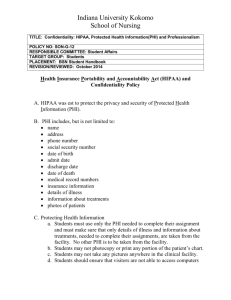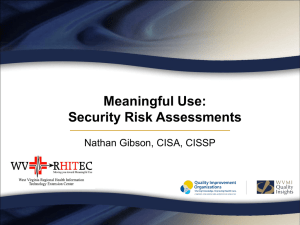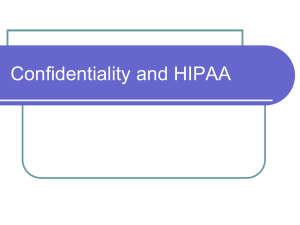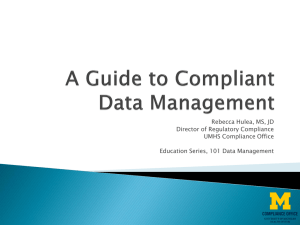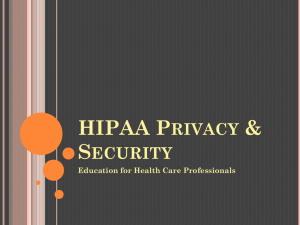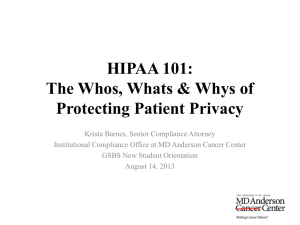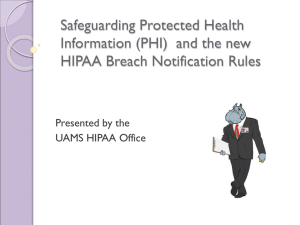HIPAA Annual Training
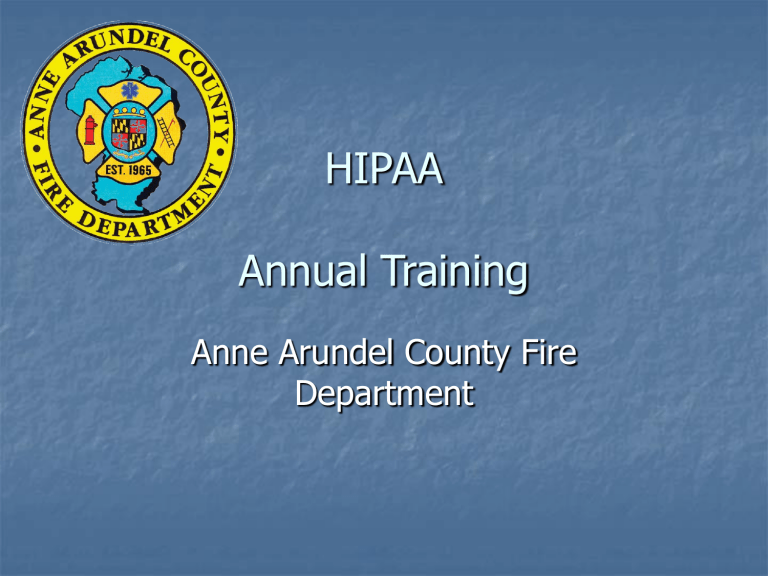
HIPAA
Annual Training
Anne Arundel County Fire
Department
What is HIPAA??
HIPAA = Health Insurance Portability and
Accountability Act
Created by – United States Department of
Health and Human Services (HHS)
Still not clear??
HIPAA is a common set of standards that protects certain health information
There are several components – but, we are most concerned with the “Privacy
Rule.”
The Privacy Rule
The intent of the Privacy Rule is to provide basic rights regarding the use of
“Protected Health Information” (PHI).
It protects all “individually identifiable health information.”
Electronic, paper, or oral
Applies to “covered entities”
Who is a Covered Entity?
Three Categories:
Health plans
Health care clearinghouses
Health care providers who transmit any health information electronically
AACo Fire Department falls under the
Health Care Provider category
What’s Required?
The Privacy Rule requires Covered Entities to:
Protect PHI
Designate a Privacy Officer
Look for “leaks” in the policy
Conduct/document training for the ENTIRE department
Develop an Authorization Form for release of
PHI
More Requirements
Develop a Notice of Privacy Practices
When permitted, always disclose only the minimum necessary PHI
Update policies and procedures
Identify Business Associates and create contracts
Apply reasonable administrative, technical, and physical safeguards
Privacy Officer
An individual within the organization that is responsible for developing and implementing policies and procedures required by HIPAA
Anne Arundel County Fire Department’s Privacy
Officer is Battalion Chief Matthew Tobia
Protected Health Information
PHI is any information created or received by a health care provider which relates to:
Past, present, or future physical or mental conditions
Provision of health care
Past, present, or future payment for care
Examples of PHI
Name
Address
Date of Birth/Age
Social Security Number
Medical condition/Past medical history
Full face photos
HIPAA should NEVER negatively impact the quality of patient care or impede the ability to provide care!!
The appropriate communication of PHI with other health care providers directly involved in providing patient care does not constitute a violation of
HIPAA.
Safeguarding PHI
PCR’s should be kept in a secure location
Networks containing PCR’s should be password-protected
Include confidentiality statements on e-mails and faxes that contain PHI
Use Caution…
Beware of discussion of PHI, such as:
Talking about current or prior incident while re-stocking ambo or writing report
Discussing a call anywhere other than an official audit or review
Discussing “interesting” calls, famous patients, or neighbors
Sharing co-workers or fellow responders PHI
Unsure About Discussing an
Incident??
Ask yourself…
Would a Judge agree that the disclosure benefited patient care AND was performed with the utmost discretion???
If you were the patient, would you want an
“embarrassing” injury or illness to be discussed?
Notice of Privacy Practices
(NPP)
The department must make a Good Faith attempt to provide a NPP to each patient
The department must also make an effort to get a signed “Acknowledgement of
Receipt”
Anne Arundel County Fire
Department’s NPP
The department sends our NPP with the request for insurance information, including a signature form which acknowledges receipt and permission to bill insurance on the patient’s behalf.
The NPP is also available on the internet at www.aacounty.org/fire . Every uniformed and civilian member of the Department with this material. must review and be familiar
A copy can be viewed on the next two slides.
NPP in Emergency Settings
During the emergency treatment of a patient, the NPP must be given as soon as practical.
The Anne Arundel County Fire Department provides the
NPP and Acknowledgement through the mail.
This ensures that the provision of this information does not interfere with patient care or become lost during the emergent phase of treatment.
Permitted Disclosures
Disclosure of PHI is acceptable in the following circumstances:
Treatment
Payment
Operations
Public Health Regulations
Victims of Abuse
Judicial proceedings
Law Enforcement
Births and Deaths
Research
Protection of Public
Safety
Treatment, Payment, and
Operations
Treatment – giving PHI to other providers involved in patient care, such as the hospital
Payment – receiving PHI from other providers, as necessary for billing
Operations – audits, quality assurance assessments
Public Health Activities
Disclosures to public health authorities, as authorized by State Law
Also allows for notification of communicable diseases to EMS providers involved in an exposure
Victims of Abuse, Neglect, and
Domestic Violence
The law requires (and HIPAA allows):
reporting an “endangered adult” believed to be a victim of battery, neglect, or exploitation to
Adult Protective Services or law enforcement
Reporting a child that is believed to be a victim of abuse or neglect to the immediate supervisor,
Child Protective Services, or law enforcement
Judicial Proceedings
Disclosure must only be made when a Judge or
Grand Jury orders disclosure through a subpoena or warrant.
**A private attorney does not have the authority to order a Fire Department provider to discuss a case. If contacted by an attorney, always contact the county’s law office for advice before proceeding.**
Law Enforcement
Disclosure of PHI to
Law Enforcement is permitted when:
Required by law
Ordered by a court
Ordered by
Administrative subpoena
Law Enforcement
When assisting the police to identify or locate a suspect, missing person, or witness, the provider may release:
Name/address
Date/Place of birth
Social Security #
Blood Type
Date/time of treatment
Distinguishing characteristics – height, weight, tattoos, scars, etc…
Law Enforcement
As patient care advocates, EMS providers should encourage law enforcement to gain information directly from the source, when possible.
Civil Penalties
The U.S. Dept of Health and Human
Services may impose civil penalties on a covered entity of $100 per failure to comply with a Privacy Rule requirement.
Criminal Penalties
A person who knowingly obtains or discloses individually identifiable health information in violation of HIPAA faces a fine of $50,000 and up to one year imprisonment.
Criminal sanctions are enforced by the
Department of Justice.
Resources
http://www.hhs.gov/ocr/privacy/hipaa/
http://www.dhmh.state.md.us/hipaa
http://www.aacounty.org/fire
NEXT STEP
Complete the Quiz
Submit a Training Report – Use Training
Course CodeHIPA11
